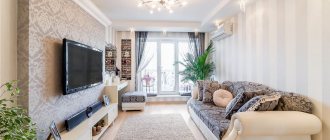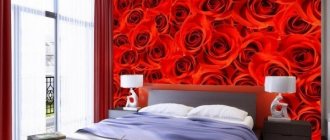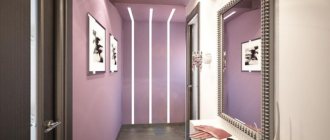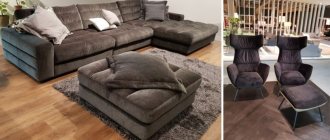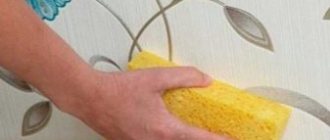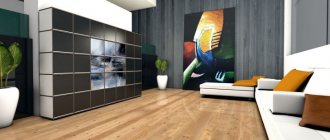Externally, Art Vinyl can imitate any surface
The floor is regularly subjected to a lot of stress, and therefore it is worth choosing a coating that will be beautiful, durable and wear-resistant. It is imperative to take into account durability, ease of maintenance and optimal cost. For such data, Art Vinyl flooring is perfect, which can be an excellent imitation of ceramic tiles, marble chips, natural stone, leather, carpeting, fabrics or any other fabrics. New generation vinyl flooring can be purchased with an original effect, such as matte, glossy or grooved.
Requirements for wallpaper material
Today, a variety of materials are used to create wallpaper (textiles, paper, liquid base), but they all must meet the following requirements:
- Safety for humans. The material used to create wallpaper must not contain harmful or toxic impurities.
- Strength. A fragile canvas on the wall can easily be damaged, this issue is especially relevant for children's playrooms.
- Resistance to moisture and temperature changes.
- Possibility of cleaning (if possible, wet cleaning).
It is also worth noting the design of the wallpaper in the apartment and the cost of the material.
Art Vinyl Laying
There are no problems with the installation of the Art Vinil Tarkett (New Age) lock variety. Each fragment has a tongue and groove that fit together without problems. The second tile is lifted up, the edge is inserted into the groove of the already lying one. after which the fragment falls to the floor. There is no need to make any effort. Check whether the planks are connected properly by running your palm along the joint.
It is necessary to lay Art Vinyl flooring at a temperature not lower than +15°C, but it is more convenient to work if the temperature is about +20°C. At this temperature, the tiles/planks are elastic and easier to work with. If the covering is laid on a heated floor, the heating must be turned off 3-4 days before the start of work. After delivery, piles of material are laid out on a flat, clean surface and left to “acclimatize” for at least 48 hours. If the material was delivered during frost, the time is increased.
Another important point: the windows in the room are curtained. So that sunlight does not create a temperature difference on the floor. Laying on a damp base is not allowed.
Tools and materials
To install the Art Vinyl Tarkett coating, the following tools are required:
- notched spatulas for applying glue (if the material is adhesive);
- cork lapping board - for smoothing the coating;
- rubber hammer - for leveling joints;
- metal roller 50-70 cm wide - to remove air and ensure high-quality adhesion to the base;
- knife - for cutting the coating to size/shape.
The flight of fancy is not limited in any way.
The glue is evenly distributed over the surface using a notched trowel.
Recommended spatulas are indicated in the technical description for the adhesive. For example, when using Ceresit K 188E Extra, it is recommended to use a notched trowel A2 or A3, depending on the structure of the reverse side of the coating. For Forbo 528 Eurostar Allround universal adhesive, notched trowel: A1/A2/B1/B2.
The adhesive consumption depends on the absorbency of the base (on a cement screed without priming it will be more than on plywood). Also, from experience, if you will be laying the coating in more than one room, take several spatulas in A1 and A2 format. They wear out quickly, especially if you lay Art Vinyl Tarket on a concrete screed.
Features of work
Please note that the geometry of the planks/tiles is not ideal. The difference is not too big - 1-2 mm, but it cannot be ignored. Before gluing, it is best to assemble the entire row of tiles, cut the required fragments to size, and then number them on the reverse side. Then you can apply glue and lay out a row.
When laying, you must first select the planks according to size and pattern - so that there are no different fragments
If the coating has a certain pattern, you need to monitor it. If you are assembling a coating that imitates parquet, make sure that the pattern of adjacent fragments does not match. To avoid color stains, use planks/tiles from several stacks at once. This gives better results. Before laying, wipe the back side of the tile with a dry, clean rag, getting rid of possible debris and dust.
When applying glue, you need to make sure that there are no places where the glue has already dried, and a new layer is applied on top. Dried glue must be completely removed (using a metal spatula with a smooth, sharp edge), and then a new layer must be applied. All areas with a double layer of adhesive can then be highlighted. Treat the laid out fragment with a metal rolling roller to remove air that may get under the vinyl tile. After 20-30 minutes, roll again. After the entire Art Vinyl Tarkett covering has been glued, wait until the glue has completely dried (indicated on the package).
Selecting wallpaper
Today in building materials stores you can find the following modern wallpaper for apartments:
- Paper wallpaper.
- Non-woven wallpaper.
- Vinyl options.
- Acrylic wallpaper models.
- Textile based wallpaper.
- Metallized coating.
- Bamboo wallpaper.
- Cork models.
- Liquid wallpaper.
- Photo wallpaper and wallpaper with 3D effect.
- Fiberglass based wallpaper.
Each of the presented options has a rich decor and a number of advantages and disadvantages in practical use.
The texture, relief and cost also differ. Therefore, before purchasing finishing materials, you should definitely calculate the required number of rolls or liquid base, and also preliminarily evaluate photos of wallpaper in catalogs from manufacturers.
Paper wallpaper in the apartment
They are distinguished by rich decor, a huge selection of colors and patterns. The advantage is the affordable price and ease of repair.
However, the paper base is not resistant to moisture, breaks easily, and often requires replacement after children's drawings, dirt, or the surface gets wet.
Note!
- Wallpaper glue - 155 photos of the best compositions. Review of manufacturers and the best glue brands
Wallpaper from Leroy Merlin: 180 photo examples and video master class on the use of different types of wallpaper
Wallpaper for the kitchen - types, types, designs and expert advice on choosing a design (165 photos + video)
Non-woven wallpaper
This type of wallpaper is easy to glue and easy to remove if repair work is necessary. The glue is applied only to the wall, and the relief structure of the material allows you to hide imperfections and unevenness on the wall.
The cost of the material is higher than for classic paper wallpaper. The advantage is the fact that some types of non-woven fabric are excellent for subsequent painting.
How to glue vinyl wallpaper: general recommendations
Before pasting any wallpaper, be sure to close all doors and windows, and ensure the temperature in the room is at least 18 °C. You need to cut the strips using a stationery or regular sharp knife in accordance with the height of the walls, but be sure to leave a margin of 7-10 cm. If you need to select a pattern: before cutting the second strip, align the pattern with the first sheet.
Pasting the ceiling with vinyl wallpaper
Dark color and large geometric pattern as a backdrop for extravagant accessories
Advice! If the wallpaper pattern has stripes (vertical or horizontal), then before gluing the wallpaper, make vertical markings on the walls using a building level. Small deviations from the vertical level will be very noticeable, especially near doorways and slopes.
Table of decoding of symbols on rolls of wallpaper
It is better to start gluing the canvases not from the corner of the wall, but from the second sheet from it or from the window. The cut canvas must be applied to the wall and aligned with the vertical markings. The canvas is smoothed from top to bottom with a special wallpaper spatula. Using movements from the middle to the edges, remove excess glue and bubbles. We glue the next strips end to end. The joints need to be rolled with a separate small elastic roller for joints. If the wallpaper is meter wide, then it is better to glue it together. The walls must be very smooth. Pasting wallpaper in the corners is the most difficult and crucial stage, since few people can boast of perfectly smooth walls. In the corner, the strip should be glued with an overlap on the adjacent wall, but no more than 1.5-2 cm. The next strip should be glued strictly from the corner line, overlapping the first one. In the locations of switches, distribution boxes and sockets, wallpaper is glued directly onto them, and then, after the glue has dried, holes are carefully cut with a stationery knife, and the switches and sockets are installed back.
Applying glue to walls
Pasting the first strip
Leveling and removing bubbles
Rolling joints with a special roller
You can learn more about how to properly glue vinyl wallpaper in this video:
Vinyl wallpaper in the interior
One of the most durable types of decorative coating among modern wallpapers. Particular strength is achieved through two layers - PVC and paper, non-woven.
Vinyl coatings are moisture resistant and resistant to mechanical damage. Rich relief and pattern allow you to give the room a special interior style.
Disputes in the design community arise over the only drawback - poor environmental performance.
What is Art Vinyl Tarkett flooring
Designers love vinyl tiles - there are many types of coating, many of them can be combined, which gives additional freedom for creativity. Builders love this flooring - it installs quickly and easily. Housewives love this same material - not only does it look great, it’s easy to clean. But, as usual, it all depends on the quality.
Art Vinyl imitating wood is most often used in apartments
One of the options with stable quality is Art Vinyl Tarkett. This is a vinyl flooring that comes in the form of tiles (squares) and planks (rectangles). Some consider this coating to be only a type of linoleum, but this is not so: the composition is different, different materials are used. Moreover, there are differences in feel - it doesn’t shine, it doesn’t stick.
Collections may differ from each other in the thickness of the layers, as they have different purposes. But the sequence of layers itself remains the same.
Composition of vinyl tiles Art Vinyl Tarkett
Composition and purpose of layers:
- Base . A special grade of vinyl that, while being highly durable, has a high degree of flexibility. The thickness of the base varies depending on the class of coating. A thicker base has increased thermal insulation properties, better sound insulation, and higher wear resistance.
- Fiberglass . Not present in all episodes. Gives greater dimensional stability (less thermal expansion).
- Decorative layer . Responsible for the appearance of the coating. Tarkett Art Vinyl not only imitates natural materials in color, it also imitates the texture.
- Protective layers . Most often there are two of them - vinyl and polyurethane. This combination allows for high wear resistance. Even with a small thickness of the coating, the protective layer is highly resistant to abrasion and mechanical damage (heels do not press through).
The main and main difference between Art Vinyl is the large number of options. It's not just about the colors and textures, but the fact that this coating can be combined to create patterns and compositions. There are ready-made installation schemes, but you can create them individually.
Textile based wallpaper
Textile models are distinguished by rich patterns and colors, relatively high cost of material and difficulties in maintenance.
It is absolutely not recommended to use such wallpaper for decorating children's rooms or dining areas. The structure is soft and susceptible to damage and may require immediate repairs.
Metallized canvas in the interior
The manufacturing technology of this type of wallpaper involves applying aluminum coating to a fabric base.
The next layer is paint and the original ornament. Due to its durable multilayer structure, the coating is heavy and resistant to moisture.
Note!
Types of wallpaper: features, pros and cons of wallpaper types. Classification by texture, number of layers, drawing (photo + video)
Wallpaper for the bedroom: TOP 140 photos and video reviews of bedroom designs with wallpaper. Suitable styles, colors and patterns of wallpaper for the bedroom, choice of materials
Gray wallpaper: features of using gray wallpaper. The choice of furniture, decoration and lighting for gray wallpaper. Photo and video design ideas
Since wallpaper has a high price, metallized canvas is often used as a relief insert against the background of vinyl or paper wallpaper.
Types of vinyl wallpaper
Vinyl wallpaper can be classified as follows:
- based on foamed vinyl, without embossing.
- hot stamping:
Stylish vinyl wallpaper for the living room
A wall highlighted with dark tropical wallpaper
Embossed texture with a pattern imitating engraving
The shine and smooth texture of silk-screen printing will create a unique atmosphere in the living room, nursery or bedroom. But they can only be glued to a perfectly level surface. Compact vinyl is a denser material than silkscreen printing. This coating can be imitation stone, plaster and textiles. Heavy wallpaper is ideal for walls that have unevenness and cracks, as they will perfectly hide all these imperfections. A thick layer of polyvinyl chloride makes the wallpaper durable and textured; they can even be used to cover ceilings. Wallpaper covering with chemical embossing has a smooth glossy surface, is easy to clean with detergents, has increased strength and resistance to ultraviolet rays.
Light, non-contrasting wallpaper with a “Turkish cucumber” pattern
Wallpaper made from natural materials
This group of finishing materials includes bamboo and cork wallpaper.
The material used for production is natural, environmentally friendly. Due to the complexity of producing decorative coatings, wallpaper has a very high cost.
However, due to the porous structure, they allow air to pass through well, preventing fungus from developing on the underlying wall.
Kinds
There are several types of vinyl top layer. Depending on thickness, noise absorption, external indicators and features, wallpaper is divided into the following types:
- smooth. Durable textured material. Vinyl wallpaper designs come in brick and stone designs. They wash well. Smooth vinyl wallpaper is not afraid of light, so it does not fade.
- solid. Wallpaper resistant to any damage. Dense structure. Capable of imitating various finishing materials. They allow air to pass through well.
- silk. Amazing wallpaper in texture and appearance. They resemble silk fabric due to their thinness and strength. The process of creating vinyl is called screen printing.
- foamed relief vinyl. The foam layer allows the wallpaper to breathe. At the same time, it has a unique clear and relief pattern. The material is not heavy and easy to work with. Such wallpaper is well suited to the design of the kitchen, as it can be considered washable. They can be easily wiped with a rag, so they are often used as a ceiling finishing material. Such wallpaper can hide all the imperfections and unevenness of the walls of the room.
Liquid wallpaper for home
The main advantages of using this group of finishing materials are:
- Easy to apply.
- The wallpaper on the walls does not form joints.
- Hiding unevenness and construction defects.
- Strength.
- Affordable price.
- Rich decor.
- Moisture resistant.
The mixture is diluted according to the attached instructions, immediately before application to the wall.
Choosing wallpaper for living rooms
The choice of a specific wallpaper model depends on the purpose of the room, the temperature climate in the room, the chosen interior style and the personal wishes of the owner.
Wallpaper of various types is often combined with each other, and original inserts are created using photo wallpaper or 3D models.
Various wallpapering options are used to visually expand space or zoning a room. Don’t forget also about the color scheme of the material for different rooms.
Choosing wallpaper for the living room
When carrying out renovations, the greatest attention is paid to this particular room - a meeting place for guests, family gatherings and festive evenings.
The color scheme is selected only according to the owner’s preferences; only too poisonous and harsh shades are excluded. An excellent solution would be to use photo wallpaper for the living room or embossed wallpaper with a 3D effect.
Original inserts made of metallized fabric allow you to decorate the living room interior in the latest trends of modern design.
Choosing wallpaper for the bedroom
The main principles for choosing a coating are safety, quality, and natural shades. For an adult bedroom, you can choose paper, vinyl, or non-woven wallpaper.
An acrylic canvas made in calm warm colors with a geometric pattern is perfect.
The nuances of gluing
There are general recommendations for all types of wallpaper. Better adhesion of the substrate to the base is facilitated by evenness, smoothness, solidity, cleanliness and the absence of oily stains, foci of biological or corrosive damage. Before gluing the canvases, it is also necessary to treat the working surface with a primer, a solution of PVA or wallpaper glue. Combined options are acceptable.
In relation to the decorative decoration of walls with foam wallpaper on a non-woven or paper base, it is worth using glue for heavy types of materials. The same can be said for primers. This is explained by the high density of modified PVC, which is reflected in an increase in the total weight of the material. The recommended adhesive differs from universal or highly specialized adhesives in that they contain additives to improve adhesion and tensile or peel strength.
According to the technology, paper wallpaper must be pre-lubricated with an adhesive solution. Next, the fabric is folded with the treated wrong side inward and kept in this state for 2-3 minutes. With vinyl samples it often takes longer. As a rule, 5 minutes is enough. But it is better to familiarize yourself with the specific period from the instructions from the manufacturer on the packaging or insert from the finishing sample.
It is generally accepted that the non-woven base is always laid on a working base coated with glue. When choosing foam wallpaper with a similar backing, it is necessary to apply the solution both to the walls and to the underside of the decorative canvas.
To impregnate the substrate with glue, you cannot fold the canvases as is the case with classic paper wallpaper. This increases the risk of damage to the soft decorative coating.
Despite the high tensile strength of materials after getting wet, they can still become deformed. Therefore, to form joints, it is unacceptable to violate the shape of the canvas. During drying, the decorative coating will be restored to one degree or another, causing the seams to separate. It will be impossible to correct them later.
The final point concerns the choice of smoothing tool. Here the main criterion is the low resistance of the coating to mechanical load, which is inevitable when gluing wallpaper. On trading floors you can find special rubberized or plastic rollers and spatulas with varying degrees of rigidity (plastic “wings”). Before their appearance and often today, moistened or dry rags are used. In order not to damage the drawing, we only allow one tool option - a roller with a rubber roller. If the vinyl flooring cannot be painted, it is important to choose an expensive, quality attachment with a relatively soft material. Cheap analogues leave a pigmented mark, while hard ones deform the texture. If you plan to paint, paint and paint materials slightly smooth out the texture of the wallpaper and cover up the marks left by an inexpensive roller.
It is better to remove glue from joints using a sponge by blotting. This way the paint and texture will remain intact.
Wallpaper to be painted should be pre-primed before finishing. This will cover any traces of excess glue squeezed out. The primer must be selected based on its binding component. It must match the base of the planned paint.
Choosing wallpaper for the hallway
Wallpaper in the hallway should be characterized by increased strength, resistance to moisture, and ease of maintenance. The best options would be vinyl wallpaper, metallic fabric, liquid wallpaper in the apartment.
The modern building materials market offers its customers a huge range of decorative coating products.
New wallpaper designs for 2020, presented in official catalogs from manufacturers and designers, will help every master make the best choice.
Vinyl foam wallpaper
Every day it becomes more and more difficult to make a choice of finishing materials, this also applies to wallpaper. The point is not in the difficulty of selecting a material of a color and texture that would best suit the interior, but in the huge range of products, widely presented in construction stores. Among the variety of materials differing in the method of fastening, structure and color of the surface, wallpaper remains the most popular and affordable finishing material.
In order to diversify wallpaper, foamed vinyl was first used not so long ago. However, as soon as vinyl wallpaper appeared on the market, they instantly won the hearts of consumers, as evidenced by exclusively positive reviews of their use. Foamed vinyl wallpaper is one of the varieties of this wonderful finishing material.
Despite the fact that the average price of such wallpaper is higher than that of ordinary paper wallpaper, they have a number of advantages over the latter. It would be preferable to buy vinyl wallpaper if the wall surface has some imperfections that need to be hidden, and in addition, such wallpaper does not stretch.
Foamed vinyl is soft to the touch, pleasant to touch, and its decorative possibilities are almost limitless: the pattern on the wallpaper can be completely different in color and structure. Often sparkles are interspersed into the top layer, which can add elegance and originality to the interior, as, for example, in the photo below.
If there are no sparkles on the surface of the vinyl, then the wallpaper can be repainted in a suitable color if desired.
Foamed vinyl wallpaper on a paper base is produced by applying a mass of vinyl to the base paper. After heat treatment, the vinyl foams and acquires texture. The resulting material has a high density, which prevents moisture evaporation. This is definitely not a positive characteristic, since there is a possibility of mold or mildew forming. Therefore, the base must be treated with a special antifungal impregnation.
Such wallpapers are also found on a non-woven base, which adds more durability and strength to them. If you want to wash vinyl wallpaper, be sure to pay attention to the marking; it should indicate how to care for the coating. One wave on the marking means the wallpaper can be cleaned with a barely damp cloth, two or three waves - you can safely wash it. If a wave with a comb is depicted, you can wash it with a sponge.
Wallpaper can be pasted onto any surface that is free of dirt and dust, excluding only whitewash and lime walls. Although vinyl wallpaper can hide small irregularities and potholes on the wall, especially large cracks should still be sealed with mortar or putty beforehand.

